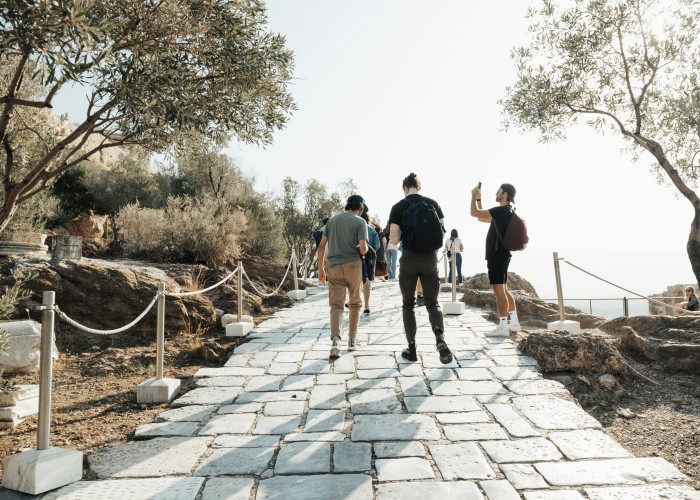If you’re dreaming of sun-drenched paths, craggy coasts, and cultural surprises around every bend, the Greek islands deliver. From the dramatic gorges of Crete to panoramic Cycladic summits, this guide covers the routes most worth lacing up for—without sounding like a robot. Whether you’re browsing from the USA, UK, Australia, or Germany, here’s your friendly, helpful roadmap to island trekking. Greece Islands & Trails.
Overview: What It Is, Where, and Why It’s Famous
Greece isn’t just white buildings and beaches. Across its islands lie hiking routes that are surprisingly rich in variety:
- Samaria Gorge (Crete): A deep, 16 km canyon that spans alpine forest before opening to sea.
- Fira‑Oia Trail (Santorini): A clifftop walk through postcard views of Aegean blue.
- Corfu Trail: A 220 km journey through olive groves, gorges, and quiet bays.
- Mount Zas (Naxos): The Cyclades’ tallest peak, with mythic views.
- Strata Trail (Naxos): A coastal cross-island trek along marble mule paths.
- Ancient trails (Andros, Sifnos, Amorgos, Milos, Skiathos) offer a blend of stones, chapels, and sea views.
Each route pairs natural beauty with islands’ history and charm. It’s hiking, Greek-style.
Best Time to Visit
- Spring (April–June) and autumn (September–October) are ideal: cooler weather and blossoming landscapes.
- High summer brings sunshine—and crowds. If trekking Santorini or Crete in July or August, start very early.
- Winter brings quiet paths—and fewer services. Stick to spring and fall for the most consistent trail access and comfort.
How to Reach the Islands
- By air: Fly into major gateways like Crete (Heraklion/Chania), Santorini, or Corfu.
- By ferry: Ferries connect Athens with most islands. Internal island routes—Naxos, Amorgos, Sifnos, etc.—are well-served in high season.
- Local transport: Many hiking routes are within reach of town centers or bus links, but not all—Santorini’s Fira‑Oia is a prime example of easy access on foot. Greece Islands & Trails.
Entry Fees & Permits
- Most island hiking routes require no permits or fees.
- Samaria Gorge charges around 5–10 euros, subject to change.
- Trails through protected parks may request voluntary contributions or fees.
- Always check local signage before you hike—some routes may limit access at certain times.
Food Availability & Meal Options
- Island towns and trailheads typically offer cafés, bakeries, and local tavernas.
- Trails like Fira‑Oia and Samaria give easy access to refreshments.
- More remote routes (Amorgos, Andros, Sifnos) may demand carrying snacks, water, and a refillable bottle—plan accordingly.
Packing List & Essentials
- Breathable clothing and layers for wind or shade
- Sturdy hiking shoes—rocky & uneven terrain is a given
- Sun protection: hat, sunglasses, sunscreen
- Daypack with 1.5–2 L water, energy snacks
- Map or GPS, especially for lesser-known trails
- Basic first-aid and blister kit
- Trekking poles optional but helpful for steeper ascents
Safety Tips & Local Regulations
- Stick to marked paths—some routes like Caldera Edge are exposed.
- Watch footing on uneven or loose stone.
- Start hikes early during summer to avoid heat.
- Respect fragile ecosystems—leave no trace, avoid trampling native plants.
- Be cautious on paths with dramatic drops—safely enjoy the views.
- If remote, hike with a companion or let someone know your plans.
Tips for Beginners or First-Time Visitors
- Start with accessible routes—Santorini’s cliff walk or Naxos’ stone trails make for great introductions.
- Build confidence with day sections rather than undertaking a full multi-day trek immediately.
- Choose spring or autumn if unsure how you’ll handle heat or distance.
- Confirm transport back if you’re doing point-to-point treks, like Samaria’s downhill exit or early ferry departures.
- Pair hiking with local delights—fresh saganaki, sea views, and slower rhythms make it all worth it.
Local Customs & Cultural Etiquette
- Greet locals with a simple “Kalimera”.
- Avoid loud discussions in religious sites or monasteries.
- Respect private land—stick to official paths.
- A small amount of Greek goes a long way: “Efharisto” (thank you) is always appreciated.
- Leave no trace—these landscapes are treasured. Greece Islands & Trails.
FAQ (SEO-Optimized)
| Question | Answer |
|---|---|
| How long is the Samaria Gorge hike? | About 16 km down through pine forests and cliff walls to the sea—plan for 4–7 hours. |
| What’s the difficulty level of the Fira‑Oia trail? | Easy to moderate. 10 km mostly level, with dramatic caldera views. Time: 3–5 hours. |
| Can you hike the Corfu Trail in stages? | Yes—220 km in total, broken into stages across olive groves and hills; good for day hikes. |
| Is Mount Zas accessible to beginners? | Moderately challenging. 8 km round-trip with rewarding summit views; good fitness helps. |
| Is hiking on Amorgos official? | Old Strata paths are marked and safe; take water and respect isolation. |
| Are restrooms available along trails? | Only at endpoint villages, not mid-trail—plan stops accordingly. |
| Is mobile signal reliable? | Generally good near towns; patchy on remote island peaks. Download maps beforehand. |
| Can kids hike? | Yes—many easy to moderate trails suit families with supervision. |
| Is camping allowed? | Typically restricted—best to stay in village accommodation or guesthouses. |
Final Thoughts
The Greek islands offer more than sun and sea. They invite you to walk through history, climb to mythic heights, and wander towns that still hum to island rhythms. From dusty gorge paths in Crete to cobbled Strada routes in Naxos, there’s a trail for every walker—beginner to seasoned traveler. Greece Islands & Trails.






Leave a Reply